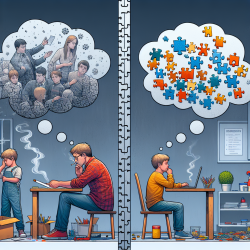Introduction
In the realm of adolescent mental health, the role of family dynamics cannot be overstated. A recent study titled "Influence of at-risk family interactions on the course of psychiatric care in adolescence" sheds light on the significant impact that family interactions have on the psychiatric care of adolescents. This research underscores the need for practitioners to integrate a comprehensive understanding of family dynamics into their therapeutic approaches.
The ARFIL Scale: A New Tool for Practitioners
The study introduces the At-Risk Family Interactions and Levers (ARFIL) scale, a 30-item clinical tool designed to assess family interactions in a psychiatric context. The ARFIL scale identifies three key dimensions of family dynamics: cohesion/conflict, love/hostility, and autonomy/control. These dimensions are crucial for understanding the family environment and its influence on adolescent mental health.
Key Findings
- Predictive Power: The ARFIL scale's intensity score predicts the duration of hospital care, independent of factors like age, gender, and medical severity. This suggests that family interactions are a critical determinant of psychiatric care needs.
- Diversity Score: The diversity score, which counts the number of at-risk interactions, correlates with both the number and duration of hospitalizations. This highlights the breadth of family issues impacting care.
- Comprehensive Assessment: The ARFIL scale offers a holistic evaluation of family dynamics, providing a valuable tool for both treatment and prevention.
Implications for Practitioners
For practitioners, the ARFIL scale offers a data-driven approach to understanding family dynamics. By incorporating this tool into clinical practice, therapists can better tailor interventions to the specific needs of adolescents and their families. This scale not only aids in treatment planning but also serves as a preventive measure by identifying at-risk interactions early.
Encouraging Further Research
While the ARFIL scale provides a robust framework for assessing family interactions, further research is needed to refine and expand its application. Practitioners are encouraged to explore the scale's use in diverse settings and populations to enhance its validity and reliability.
Conclusion
Understanding family dynamics is essential for effective adolescent psychiatric care. The ARFIL scale represents a significant advancement in this field, offering practitioners a powerful tool to assess and address family interactions. By embracing this data-driven approach, clinicians can improve outcomes for adolescents and their families.
To read the original research paper, please follow this link: Influence of at-risk family interactions on the course of psychiatric care in adolescence.










